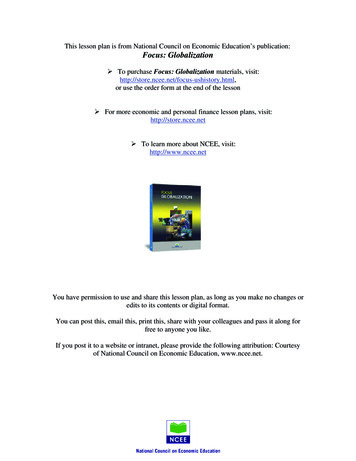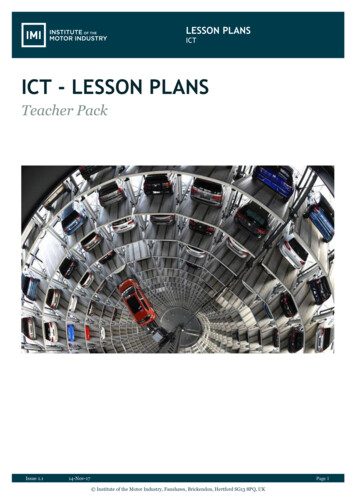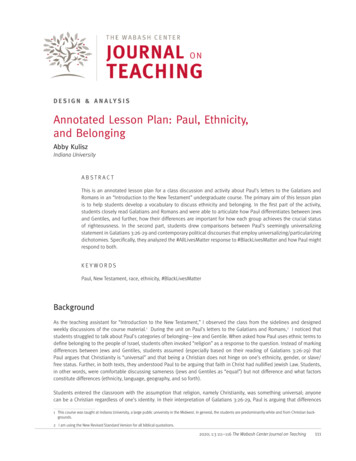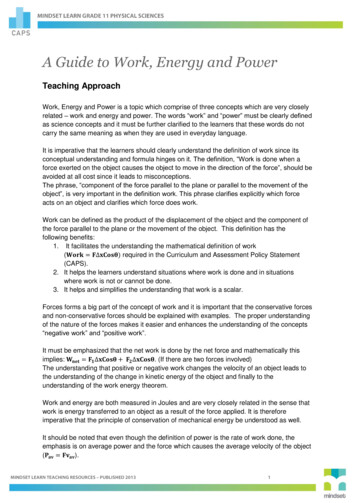
Transcription
This lesson plan is from National Council on Economic Education’s publication:Focus: GlobalizationTo purchase Focus: Globalization materials, r use the order form at the end of the lessonFor more economic and personal finance lesson plans, visit:http://store.ncee.netTo learn more about NCEE, visit:http://www.ncee.netYou have permission to use and share this lesson plan, as long as you make no changes oredits to its contents or digital format.You can post this, email this, print this, share with your colleagues and pass it along forfree to anyone you like.If you post it to a website or intranet, please provide the following attribution: Courtesyof National Council on Economic Education, www.ncee.net.
LESSON ONELESSON ONEWHY ISGLOBALIZATION SOCONTROVERSIAL?LESSON DESCRIPTIONThis lesson provides an overview of themajor issues that have been raised in thedebate over globalization. After a briefintroductory reading, students are assigned tovarious roles in a much longer reader’s theateractivity depicting protests that take place at a(fictional) future meeting of the World TradeOrganization in New York. Following a briefdiscussion of this skit students collect andorganize arguments on both sides of thedebate, and then work in small groups todesign and produce signs that might be carriedat the protests, by either supporters oropponents of globalization.INTRODUCTIONGlobalization is driven by an increasinglyinterdependent and international economicsystem, but entails many political,technological, and cultural changes that affectindividuals, communities, businesses, andgovernments all around the world. Manypeople equate globalization with the growth ofmultinational or transnational corporationsand with much more prominent roles forinternational institutions that oversee worldtrade and finance, such as the InternationalMonetary Fund.Few recent issues have generated more debateand public protest than globalization. Forexample, at 1999 meetings of the World TradeOrganization (WTO) in Seattle, more than50,000 protesters smashed windows ofinternational corporations and confrontedpolice for several days. One reason forprotests at these and other WTO meetings(including meetings in Montreal andBrussels), is what many opponents ofglobalization see as unfair trade practicessanctioned by the WTO. They argue that thefree trade policies supported by the WTObenefit large corporations and rich nations butlead to greater poverty, inequality, loss oflocal culture, and environmental damage,especially in poorer, less developed nations.Supporters of free trade and globalizationdismiss those claims, and instead argue thatremoving trade barriers such as tariffs andquotas allows production and capital to beallocated more efficiently. That increasesproduction and competition, lowers prices,and gives consumers a greater range of choicein products. That in turn promotes economicgrowth and efficiency in general, and capitalinvestments in developing nations inparticular, raising income levels and thestandard of living in all countries that aremore open to trade. Supporters of the WTOargue that, far from being unfair, WTOpolicies reflect the desires and best interests ofits nearly 150 member countries.CONCEPTSEconomic institutionsBarriers to tradeVoluntary exchangeSpecializationFactor endowmentsGains from tradeCONTENT STANDARDSVoluntary exchange occurs only when allparticipating parties expect to gain. This istrue for trade among individuals ororganizations within a nation, and amongindividuals or organizations in differentnations.When individuals, regions, and nationsspecialize in what they can produce at thelowest cost and then trade with others, bothproduction and consumption increase.From Focus: Globalization, National Council on Economic Education, New York, NY31
LESSON ONEMATERIALSBENCHMARKSVoluntary exchange among people ororganizations in different countries givespeople a broader range of choices in buyinggoods and services.Like trade among individuals within onecountry, international trade promotesspecialization and division of labor andincreases output and consumption.As a result of growing internationaleconomic interdependence, economicconditions and policies in one nationincreasingly affect economic conditions andpolicies in other nations.Two factors that prompt international tradeare international differences in the availabilityof productive resources and differences inrelative prices.OBJECTIVESStudents will: Identify who benefits and who loseswhen a trade barrier such as sugar orautomobile import quotas iseliminated. Explain why the United States nolonger has a comparative advantage inthe production of some products itonce exported. Identify and discuss major argumentsfor and against globalization,particularly policies that encouragefree trade among nations.TIME REQUIREDTwo class periods. In class periods ofabout one hour, the suggested coverage is:Period 1, Procedures 1–4; Period 2, Procedure5, Closure, and Assessment Visual 1: WTO Protests: Seattle, 1999Activity 1: The Debate overGlobalization: A Brief Overview (onecopy per student)Activity 2: “The Earth is Not For Sale:The Debate Over Globalization,” AReader’s Theater (one copy per student)Activity 3: Summarizing the Argumentsin the Globalization Debate (one copy perstudent)Activity 4: Representing the Debate:Making Protest Signs (one copy perstudent)Activity 5: Crossword: The Debate overGlobalization (one copy per student)PROCEDURES1. Ask students if they remember theprotests that occurred in Seattle, Washingtonin 1999, and what those protests were about.Display Visual 1; describe the protests andsummarize the major issues involved.2. Distribute Activity 1. Explain tostudents that this brief activity will give theman overview of the issues on both sides of thedebate that sparked the protests in Seattle.Have students read the overview and answerthe questions that follow. Briefly discussstudent responses:A. Which author(s) supportsglobalization? Why does he or shesupport it? (Dr. Razeen Sally:"Globalization, then, is growthpromoting.”)B. Which author(s) opposesglobalization? Why does he or sheoppose it? (Duncan Green and ClaireMelamed: "While globalization hasled to benefits for some, it has not ledto benefits for all.”)C. What are two examples of the impactof increased globalization on your life?32From Focus: Globalization, National Council on Economic Education, New York, NY
LESSON ONE(clothes and music from othercountries, impact of terrorism, etc.)3. Distribute copies of Activity 2: “TheEarth is Not For Sale ” Assign students totake the 20 roles in the reader’s theater script.Have students write in the names of thoseplaying each role. Explain that the entire classwill speak the lines for the “Group ofProtesters,” so all students will have at least asmall speaking role.4. Have students read Activity 2 inreader’s theater format. Then distributeActivity 3, and give students 15-20 minutes tocomplete it. Allow students to review thereader’s theater script as they answer thequestions, if they wish. Review students’answers to the questions in Activity 3:CharacterFor/againstglobalization?Protester 1AgainstProtester 2AgainstManager 1ForManager 2ForProtester 3AgainstUnionrepresentativeAgainstIT employeeAgainstEconomicsstudent 1ForEconomicsstudent 2ForSupportingevidenceWearing “No MoreSweatshops” Tshirt; “most peoplelive on less than 1.00/day”“ dirty,dangerous. And thepay is awful ”“ percent ofpeople who aremalnourished hasdropped ”“ making 2-3times what shewould makeotherwise ”“ most making 11cents to 17 cents perhour ”“ now our jobs aregoing to China orMexico.”“ 2,500 U.S.companies havesent jobs overseas.”“ between 1993and 2002, the U.S.added more than 18million jobs.”“We still makeplenty of things, justnot the things wearen’t competitiveat.”Mr. Singh,WTO delegateBoardMember,Ox-FamInternationalWall Streetfloor trader“ WTOagreements aredesigned to lowerand eventuallyeliminate all tradebarriers.”ForAgainstForArt galleryownerAgainstUN delegate 1ForUN delegate 2AgainstArguments of thosewho support free tradeand greater access tomarkets (globalists)“ the WTOcontinues to allowthe U.S. to holdunfair advantages.”“ sounds like youare saying that youknow what’s betterfor them than theydo.”“ localcultures getpushed out by thebig, loud Americanculture.”“ best hope fordevelopingnations.”“ growth does notprovide a solutionto all problems.”Arguments of thosewho oppose free tradeand greater access tomarkets (antiglobalists)1. Poverty, infantmortality, etc. all downas a result of increasedtrade.1. Increases povertyand income inequality2. Trade is the besthope for growth fordeveloping nations,increasing incomelevels.2. The U.S. is exportingjobs overseas to low wage countries.3. Multinationalcorporations often paywage premiums abovegoing wage rates indeveloping countries.3. Multinationalcorporations exploitworkers in sweatshopsand pay less than 1.00/day.4. Only 2% of U.S.manufacturing job lossis due to outsourcing,and the U.S. is a netservice exporter.4. The U.S. doesn’treally play/trade fair–itsagricultural subsidies arereally trade barriers.From Focus: Globalization, National Council on Economic Education, New York, NY5. Local cultures arecrowded out byimporting Western goodsand ideas.33
LESSON ONE5. Ask students to recall the details of the1999 Seattle protests. Remind students thatdemonstrators carried signs so their messagecould be captured by the media. (NOTE:HistoryLink.org has an excellent slideshow ofimages from Seattle: http://www.historylink.org /essays/output.cfm?file id 7117).Explain to students that they will be creatingtheir own protest signs or posters that supportone side or the other in the globalizationdebate. Distribute Activity 4, and assigngroups of three students to represent eithersupporters or opponents. Have studentsreview the directions and make certain theyunderstand what is expected. Tell studentsthat they will also be expected to make a brief(two or three minute) presentation describingtheir poster to the class. In thesepresentations, students should summarize howtheir poster represents some of the keyarguments for their position on the debate.9The globalizationdebate centers onfree trade's impacton poverty ;critics say free tradeincreases it,supporters claimfree trade reduces it.2Term used to describeU.S. businesses hiringworkers in foreigncountries because theyhave lower wage rates.Outsourcing10Critics ofglobalization arguethat all workersdeserve a livingwage.3Critics of globalizationclaim the U.S. ishypocritical in arguingfor free trade andkeeping its ownagriculturalsubsidies , which actas trade barriers.4In order to attract thebest workers,corporations often paytheir local workers indeveloping countries awage premium ,several times higherthan the prevailingwage.5Supporters ofglobalization claim thatfree trade can result ingreater economicgrowth fordeveloping nations.6World merchandisetrade has increased overthe last 30 years, due inpart to greatly reducedtransportation costs.7Organizationresponsible fornegotiating andmaintaining tradeagreements amongmember states: WTO.CLOSUREAsk students if they believe that consensusin the debate over globalization will bereached anytime in the near future. Why orwhy not? Ask students to briefly summarizeone or two points (e.g., the impact ofglobalization on economic growth) for whicheach side differs substantially in their views.How could that disagreement be resolved, orcan it never be resolved?ASSESSMENTDistribute Activity 5. Have studentscomplete the crossword puzzle and reviewresponses.Key for Activity 5:834ACROSSCompanies that dobusiness in morethan one nation.MultinationalCorporations1DOWNSupporters ofglobalization argue thatthe greater a nation'seconomic freedom, thegreater its politicalfreedom will be as well.From Focus: Globalization, National Council on Economic Education, New York, NY
LESSON ONEVisual 1WTO Protests: Seattle, ml)Who: Union organizers, environmentalists, animal rights activists,and senior citizens protested during a World Trade Organization(WTO) meetingWhat: Attempt by protesters to shut down the WTO meeting byblocking major roads, breaking windows of major downtownbusinesses, engaging policeWhen: November 30–December 2, 1999Where: Downtown Seattle, WashingtonWhy: Protesters believed that WTO policies promoting greaterfree trade were bad for the environment, increased world poverty,and only made large corporations wealthy. WTO supportersbelieve that free trade improves living standards around the world,which in turn leads to increased human rights, literacy rates, andeven life expectancies.From Focus: Globalization, National Council on Economic Education, New York, NY35
LESSON ONEActivity 1The Debate over Globalization: A Brief OverviewReports about globalization, and the debate surrounding it, appear in the media almost every day. Evenmore important, globalization affects our everyday lives. For example, the clothes we wear are usuallyproduced in other countries, while music by U.S. artists is heard by people in other countries, too. Someterrorist organizations have their own global networks. These are only a few examples of the how peoplein the United States are increasingly connected to people and countries around the world. Otherexamples can be seen when an American company hires workers in India to handle its technologysupport program, or in the proliferation and rising prominence of international organizations such as theUnited Nations, the World Bank, the World Trade Organization, and the International Monetary Fund,which were founded to deal with global problems including peace and security, economic growth anddevelopment, the environment, health, and international trade.What is globalization, exactly? Nobel prize-winning economist Joseph Stiglitz defined globalization as“the closer integration of the countries and peoples of the world which has been brought about by theenormous reduction of costs of transportation and communication, and the breaking down of artificialbarriers to the flows of goods, services, capital, knowledge, and (to a lesser extent) people acrossborders.”1 Over the past 50 years, the exponential growth of technology–primarily computer andcommunication technologies–has improved the ability of people and firms in all countries to accessknowledge and to build links with people and firms in other parts of the world. Computers and othertechnologies have also reduced transportation costs, making it less expensive to import or export goodsand services. This has led to dramatic increases in international trade and improved standards of livingfor millions of people.Despite that, there are outspoken opponents of globalization. One key issue that divides supporters andopponents of globalization is the role it plays in causing or curing global poverty. Advocates ofglobalization want to continue to increase international trade and reduce trade barriers, such as tariffs andquotas, because they believe that offers a better chance for promoting economic growth in the developingnations of the world. Opponents claim that, instead, international trade and free markets have been amajor cause of increased poverty and growing income inequality in developing nations. Here are twoquotations that characterize this part of the debate:"Globalization, then, is growth-promoting. Growth, in turn, reduces poverty. .(T)heliberalization of international transactions is good for freedom and prosperity. The anti-liberalcritique is wrong: marginalization is in large part caused by not enough rather than too muchglobalization." (Dr. Razeen Sally, London School of Economics)2"While globalization has led to benefits for some, it has not led to benefits for all. The benefitsappear to have gone to those who already have the most, while many of the poorest have failed tobenefit fully and some have even been made poorer." (Duncan Green, Policy Analyst at the CatholicAid Agency for England and Wales; and Claire Melamed, Head of Trade Policy, Christian Aid)31Joseph Stiglitz, Globalization and Its Discontents. W.W. Norton and Company, New York, NY: 2003.Razeen Sally, “Rival visions of globalisation - anything new after September 11th?” Global Dimensions: LondonSchool of Economics, accessed ns/research/rivalVisionsOfGlobalisation/) on September 26, 2005.3“A Human Development Approach to olicy/polhumdevglobfull.shtml )236From Focus: Globalization, National Council on Economic Education, New York, NY
LESSON ONEActivity 1 (continued)Questions:1. Which author(s) supports globalization, and why does he or she support it?2. Which author(s) opposes globalization, and why does he or she oppose it?3. List two ways that globalization has affected your life.From Focus: Globalization, National Council on Economic Education, New York, NY37
LESSON ONEActivity 2“The Earth is Not For Sale: The Debate OverGlobalization”A Reader’s TheaterCharactersPlayed byNarratorSue Henry, news directorDavid Richards, radio reporterAbbe Smith, radio reporterProtester 1Protester 2Manager 1Protester 3Manager 2Union representativeIT employeeEconomics student 1Economics student 2Mr. Singh, WTO delegateBoard member, Ox-FamInternationalRetireeWall Street floor traderArt gallery ownerUN delegate 1UN delegate 238From Focus: Globalization, National Council on Economic Education, New York, NY
LESSON ONEActivity 2 (continued)Setting (read by the Narrator):New York City, near Wall Street. The World Trade Organization is meeting to discuss a new roundof trade agreements, despite another round of protests from those who oppose globalism, andespecially the expansion of free trade between the nations of the world. Protesters are lined up oneither side of Wall Street, held back by barricades and police officers, including some on horseback.The police are there to keep Wall Street, the street that represents the heart of the U.S. and worldfinancial network, open for business. Two reporters from a New York radio station are also walkingthe street, looking for a story and trying to understand what the debate is all about. Both reporterswould admit, if asked, to knowing very little about the issues that so many of the protestersobviously feel strongly about. The reporters’ job is to conduct live interviews with several protestersduring the noon news show. The news show is hosted in the studio by the radio station’s newsdirector, who has decided to make this the top news story of the day. Because it is the lunch hour,many of the people who work in the financial district–traders, managers, and secretaries–will also beon the street, adding to an already chaotic situation. It’s almost time for the live broadcast to begin.Sue Henry, news director: (in a quiet voice) Ok, we are live in 3, 2, 1 (in regular voice)Welcome to WTRD, I am Sue Henry, your host for Noon Magazine, a show that focuses on one keystory unfolding in our great city each day, with expanded live news coverage. Today’s story is onthe protests on Wall Street. The World Trade Organization is holding meetings in New York thisweek, and thousands of protesters have lined the street, chanting and singing. For more backgroundwe go to one of our reporters in the field, David Richards David?David Richards: Yes, Sue, I am here on a very crowded Wall Street with protesters chanting allaround me Group of Protesters: People before profits! People before profits! People before profits!David Richards: Many of these folks are against the growth of global free trade. They believeunfettered, so-called laissez faire, free trade, is to blame for increases in poverty, income inequality,and environmental damage in recent decades. They claim that the elimination of tariffs and otherbarriers to trade have simply allowed large, multinational corporations to move into and exploitdeveloping nations, while hurting many U.S. workers and families, too.Sue Henry: Thanks, David, stay close by now we turn to Abbe Smith, also on Wall Street, but abit closer to the New York Stock Exchange. Abbe, what can you add?Abbe Smith: Sue, the other side of this global debate–you might call them free-trade advocates–argues that opening up markets and international borders to free trade has had all kinds of benefitsfor developing nations, as well as the United States and other industrialized nations. They cite datashowing increased life expectancy, increased literacy, more political freedom, and a reduction in theproportion of people living on less than 1.00 per day in the developing nations.From Focus: Globalization, National Council on Economic Education, New York, NY39
LESSON ONEActivity 2 (continued)Sue Henry: David and Abbe, will you walk through the protesters there and see if you can get someinterviews?David Richards: I will, but it might be hard to hear over this shouting Group of Protesters: Capitalism? No thanks! We’ll shut down your banks! Capitalism? Nothanks! We’ll shut down your banks!David Richards: Ma’am, I’m from WTRD radio. Could I ask you why you are here?Protester 1 (wearing a “No More Sweatshops” T-shirt): The unbridled expansion of capitalism andfree trade has allowed large, multinational companies to exploit developing countries, and especiallytheir poorest citizens who are often forced to work for less than 1.00 day.Protester 2: That’s right once the borders of developing countries are open, big corporations canmove in and set up factories. Many of the factories set up by these big companies are sweatshops–dirty, dangerous, and the pay is awful. We are here protesting for a ‘living wage’ for all foreignemployees of U.S. corporations.David Richards: These two people who don’t look like protesters were walking by and shakingtheir heads at what you said. Let’s see what they have to say.Manager 1 (works for a large corporation; is on her way to lunch with a friend, Manager 2): I’vebeen listening for the last few minutes and I want to correct some common misconceptions aboutglobalization and large corporations. Evidence shows that the proportion of people living on 1.00per day or less has decreased by 50% in the last 20 years, which was a period of rapid worldeconomic growth, largely because of international trade. And the percentage of people who aremalnourished has dropped from 56% in the 1960s to only 10% today. Again, during a period ofglobal economic growth, fueled by trade.Protester 1: I don’t know about all these numbers, but I do know that the world’s poor make ourshirts and our shoes and get paid less than one-twentieth what U.S. workers make Manager 2: but its not just about a simple comparison of wages. You have to ask about standardsof living with and without investment by international firms. If a person making 0.50 an hour ismaking 2 to 3 times what she could make otherwise, isn’t she better off?Protester 3 (overhearing the conversation): Better off compared to whom, Bill Gates? To theWalton family? In Bangladesh, workers make shirts for large U.S. companies. Most are womenwho regularly work 14-hour days and sometimes even longer. Most make 11 cents to 17 cents anhour, hardly enough to support themselves, much less a family.Manager 1: Look, our corporation has a factory in Vietnam. Last year our factory there paid 2times the local wage. That was a big step up for those workers, and it made sense for us, too,because it meant we could get the most productive local workers.40From Focus: Globalization, National Council on Economic Education, New York, NY
LESSON ONEActivity 2 (continued)David Richards: Sue, this debate continues, but I am going to kick it back to you, because I knowyou want to get Abbe on the air Sue Henry: Thanks David. You know, in preparation for this show, I read a study by twoeconomists that found that the more free and open to trade a country is, the lower its United Nations’Poverty Index. More trade, less poor Interesting we’ll see if Abbe can shed some light on thisquestion Abbe?Abbe Smith: Thanks Sue Group of Protesters: Teamsters and turtles together at last! No, No, No, Don’t Ship Our Jobs toMexico! Teamsters and turtles together at last! No, No, No, Don’t Ship Our Jobs to Mexico!Abbe Smith: As you can hear, the protesters on this side of Wall Street are opposed to‘outsourcing’ American jobs. Sir, what brings you here today?Union representative: I’m tired of these large, unfeeling corporations sending our good payingmanufacturing jobs overseas to some factory where workers make 1.50 an hour That’s what’shappening in the textile industry, the steel industry, and the auto industry, too. These are industriesthat built America and now our jobs are going to China or Mexico.Information technology (IT) employee: That’s right, in my company we just started outsourcingour tech support to India Employees in India make only one-eighth of what we do here in theU.S. I heard more than 2,500 U.S. companies have sent jobs overseas Union rep.: that’s right. And when all the manufacturing and technical jobs are gone to Mexicoand India, we’ll be a nation of short-order cooks, store clerks, and waitresses not exactly a strongindustrial base Economics student 1 (wandering by the conversation with Economics student 2): Wait a minute,you make it sound like the increase in global trade has led to these problems and that the U.S. isrunning out of jobs. I learned that people said the same thing in the 1960s and the 1980s–that we’dbecome a nation of burger flippers. That didn’t happen. In fact, between 1993 and 2002, the U.S.added 18 million more jobs than it lost. High paying jobs in management and in specializedprofessions have grown by 20 million and now account for a third of all U.S. jobs And only about2% of the 15,000,000 American job losses each year are due to outsourcing.IT employee: My point exactly. We don’t ‘make’ anything in this country any more, we ‘manage’it Economics student 2: But industrial manufacturing climbed 93 percent between 1980 and 2003.We still make plenty of things, just not the things we aren’t competitive at. For example, China nowmakes most of the worlds T-shirts, while the U.S. makes most of the world’s large commercialaircraft. We could take over the T-shirt industry, but at what cost–we’d have to use resources andworkers from our aircraft, and other, industries. Is this what we really want?From Focus: Globalization, National Council on Economic Education, New York, NY41
LESSON ONEActivity 2 (continued)Union rep.: But how can we compete with countries that don’t have child labor laws, don’t enforcepollution controls, and don’t have worker safety laws Of course they will have an advantage overus. We can bring back our manufacturing jobs by only buying “made in America!”Economics student 1: That’s a popular view, and an old one–that we should just buy American andour manufacturing jobs will return. But we just read a study of the American automobile industry,and only 21% of the employees in the industry are actually employed in making the cars. More thanthree-quarters are in service industries like mechanics and sales people. These folks don’t really carewhere the car is made so long as it’s sold and used in the U.S.! Service industries employ moreand more people, in highly trained, professional jobs in medicine, law, and financial services, too–not just flipping burgers at McDonalds or selling things at stores in the malls, although those are stillgood jobs for a lot of people, too.Abbe Smith: I’m sorry, but I need to send it back to Sue Henry. Before I do, I should add that inresearching this story I read that the recent decline in manufacturing employment in the U.S. wasdue not to imports, but to the recent recession and increases in U.S. labor productivity. In fact, mosteconomists believe that expanding overseas markets–through free trade–would be a shot in the armfor American manufacturing.Sue Henry: Thanks Abbe We now go to David Richards who has a delegate from the WTO withhim Group of Protesters: Hey Hey, Ho Ho the WTO has got to go! Hey Hey, Ho Ho the WTO hasgot to go!David Richards: That’s right Sue, I am joined by Mr. Singh, a delegate to the WTO conference–and a few very loud protesters. First, Mr. Singh, can you tell us what the WTO does?Mr. Singh: Thank you. The WTO is an international organization dealing with the rules of tradebetween nations. The WTO has nearly 150 nations as members, and the WTO agreements among allof these nations are designed to lower and eventually eliminate all trade barriers. Ultimately thathelps people all over the world get more goods and services to consume at the lowest possible prices.But WTO agreements also help producers of goods and services, including both exporters andimporters, operate their businesses more efficiently.David Richards: Mr. Singh, the WTO has been accused of being a tool of the rich nations andcorporations, dictating to the poor countries, destroying jobs, and ignoring the environment. How doyou respond?Mr. Singh: The WTO does not tell nations how to conduct their policies. We are member-driven,with member nations voluntarily agreeing to participate and negotiating new agreements everydecade or so. We are not for free trade at all costs, but we do aggressively support the reduction oftrade barriers. And our agreements have many elements that take the environment and developmentof poorer nations into account 42From Focus: Globalization, National Council on Economic Education, New York, NY
LESSON ONEActivity 2 (continued)Board member, Ox-Fam International (breathlessly ) Here he is we were told a delegate wasgiving an interview here. Let me say that the WTO is hypocritical. They claim that they want freetrade, lower trade barriers, and yet the
Reader's Theater (one copy per student) Activity 3: Summarizing the Arguments in the Globalization Debate (one copy per student) Activity 4: Representing the Debate: Making Protest Signs (one copy per student) Activity 5: Crossword: The Debate over Globalization (one copy per student) PROCEDURES 1.











